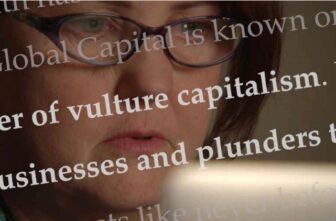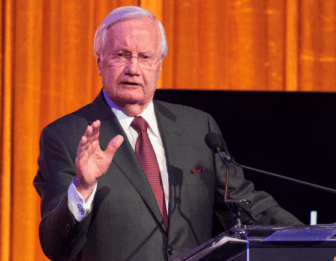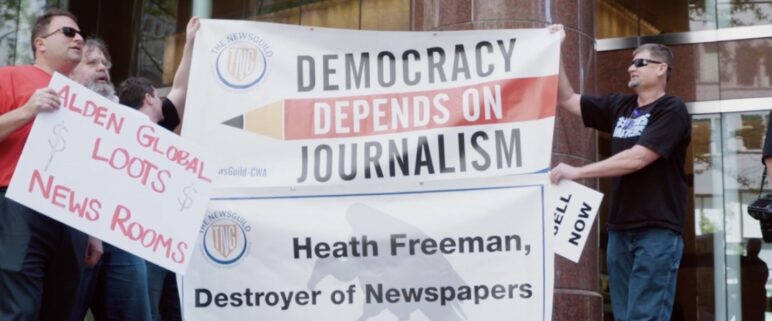Bill Moyers sparks Stripped for Parts: American Journalism on the Brink
By Rick Goldsmith, documentary filmmaker
SPONSORED
America lost one of its greatest journalists this past June. Bill Moyers was a beacon who inspired millions, including me.

Moyers published Newsday, the smart and engrossing daily I read as a teenager growing up on Long Island, N.Y., in the late 1960s. I was inspired and educated by Moyers’ hard-hitting broadcast journalism, first on CBS and then for many years on PBS.
Moyers’ journalism displayed a bottom-up perspective, showing how current events affected the least of us, the common folk. His interviews gave a voice to people who held the short end of the wealth-and-power stick. He championed those who fought back with purpose, for themselves and for a better society. As I pursued a career in documentary filmmaking, I incorporated Moyers’ principles and approach into my work.
But his greatest impact on me occurred when I got to know him personally. My recent film, Stripped for Parts: American Journalism on the Brink, soon to be broadcast on PBS stations nationwide, owes its birth to Bill Moyers.
In 2017, I approached Moyers for a documentary on his own life in journalism. He demurred, “Who, me? No one would be interested.” But I was flattered to hear that he knew my work and admired it. We agreed to look for a suitable project to work on together and discussed a few possible ideas, but nothing quite gelled. Disappointed, I thought that was the end of it. Then, months after our first encounter, I was surprised to receive an email from the legendary journalist:“I’m at the barber shop right now but when I read this I thought: Here’s a film only Goldsmith would take on. I’ll call you when I get home.” Moyers had linked me to a Nieman Lab article by media-industry-watcher Ken Doctor about the hedge fund Alden Global Capital, which was “making so much money wrecking local journalism it might not want to stop anytime soon.”

Three things from the article jumped out at me. First was the notion that the profits were to be made by “wrecking” journalism, rather than practicing it. (Why?) Second was the revelation that money could be made from an industry seemingly in collapse. (How?) Third — and this is what hooked me — was the fact that newspapermen and women were in open revolt against their own publisher. (Now that’s news!)
My production team dove into the material, and the film took shape as three interwoven narratives: an investigative reporting piece on a “vulture capitalist” hedge fund that plunders America’s newspapers; a story of working journalists putting their livelihoods in jeopardy (reporters are taught to report, not protest!); and a portrait of risk-takers creating, usually with scant funding, new models intended to rebuild, reimagine and reinvigorate local journalism, and with it, our very democracy. All very Moyers-esque, you might say — i.e. addressing the essential question, “How can our current journalism better serve the public?”

For more than a half-century, Moyers pushed the envelope about what journalism in America should and could be. He helped launch public television as a member of the 1967 Carnegie Commission that proposed an institution that would be “a forum for controversy and debate,” “provide a voice for groups in the community that may otherwise be unheard” and “help us see America whole, in all its diversity.”
But Moyers was also well aware of the vulnerabilities of public broadcasting. As keynote speaker, he cautioned a National Media Reform Conference audience in 2008, eerily foreshadowing today, “When the state becomes the guardian of power and privilege to the neglect of justice for the people who have neither power nor privilege, you can no longer claim to have a representative government.”
He implored the auditorium full of journalists, “It’s up to you to tell the truth about what’s happening to this country we love. It’s up to you to tell the truth about the struggle of ordinary people. It’s up to you to remind us that democracy only works when citizens claim it as their own. It’s up to you to write the story of America that leaves no one out.”
That is exactly the story that Stripped for Parts tells: of working reporters and editors who step outside their comfort zone to uncover secrets, sound the alarm and demonstrate what will be lost if we let watchdog journalism wither and die.

And how ironic that the film is airing on public television, itself having been stripped of funding and now fighting for its very existence.
If there ever was a time for journalists to heed Moyers’ calls to action, it is now.
Rick Goldsmith has been producing and directing documentary films for more than four decades, his most acclaimed films focusing on journalism: Tell the Truth and Run: George Seldes and the American Press (1996) and The Most Dangerous Man in America: Daniel Ellsberg and the Pentagon Papers (2009), both Academy Award nominees for Best Documentary Feature. His Stripped for Parts: American Journalism on the Brink will be shown on PBS stations as part of APT Exchange, presented by Rocky Mountain PBS, beginning Oct. 1.


